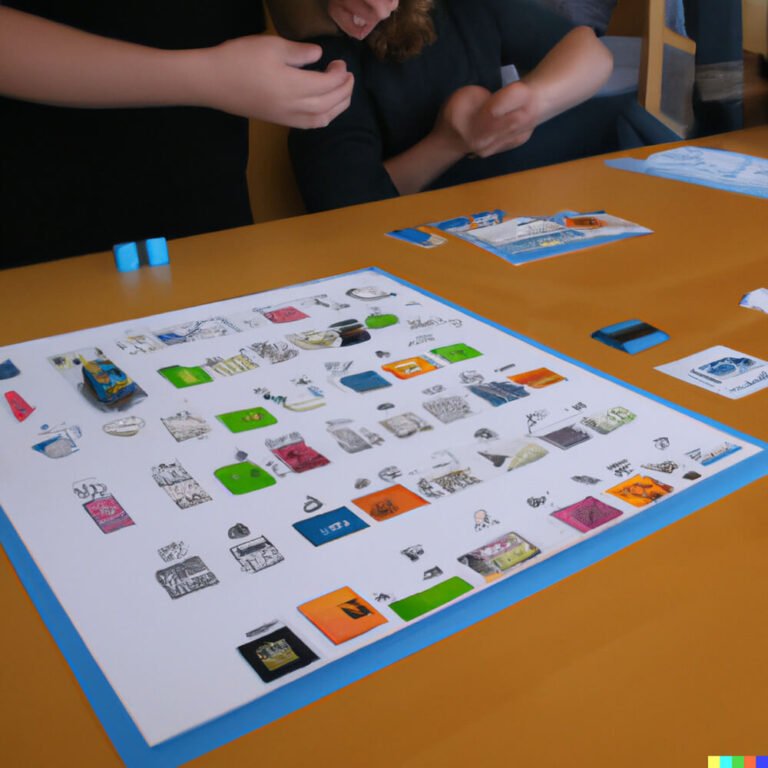Are you ready to revisit the nostalgic joy of playing Trouble, the classic board game that has been a beloved favorite for generations? In this article, we will explore the iconic game’s history, rules, and strategies, as well as provide step-by-step instructions for setting up and playing.
Whether you’re new to the game or looking to brush up on your skills, this comprehensive guide to Trouble Board Game Rules will have you ready for hours of fun with family and friends.
Trouble is a timeless game that has remained popular with families for decades. The simple yet exciting gameplay makes it a perfect choice for all ages, from young children to adults looking to relive their childhood memories. In this section, we will delve into the history of Trouble and how it rose to become a classic family favorite. From its origins to its enduring appeal, we will uncover why this game continues to stand the test of time.
Get ready to roll the dice and navigate your way around the iconic Pop-O-Matic bubble in our comprehensive overview of classic Trouble Board Game Rules. From setting up the board to understanding gameplay mechanics and strategies, we’ve got you covered. So, grab your gameboard and let’s dive into the world of Trouble.
History of Trouble
The history of Trouble is a fascinating journey into the world of classic board games. Created by Fred Kroll and initially manufactured by the Kohner Brothers, Trouble made its debut in the early 1960s and quickly became a household favorite. The game’s simple yet addictive nature captured the hearts of families and friends, cementing its status as an iconic board game.
The concept of Trouble was inspired by the traditional Indian game Pachisi, which was brought to England in the late 19th century as Ludo. This game involved moving pieces around a board based on the roll of dice, much like Trouble. Taking elements from Pachisi and adding their unique twist, Kroll and the Kohner Brothers created a game that would stand the test of time.
With its colorful Pop-O-Matic dice-rolling mechanism and distinctive plastic playing pieces, Trouble became an instant hit. The game’s enduring appeal led to various editions and adaptations over the years, ensuring that new generations continue to enjoy this timeless classic.
In today’s gaming world, Trouble remains a beloved choice for family game nights, gatherings with friends, or even as a nostalgic solo activity. Its blend of luck and strategy makes it suitable for players of all ages and skill levels, ensuring that Trouble will continue to be a cherished part of board gaming culture for years to come.
| Classic Board Game | Trouble |
|---|---|
| Game Creator | Fred Kroll |
| Debut Year | Early 1960s |
| Inspiration | Pachisi/Ludo |
Setting Up the Game
Assembling the board for Trouble is a straightforward process that can be done in just a few minutes. To start, unfold the game board and lay it flat on a stable surface. Each player should choose a color (red, blue, green, or yellow) and place their four pegs in the matching color “Home” space on the board. The “Pop-O-Matic” dice roller should be placed in the center of the board within easy reach of all players.
Next, shuffle the deck of cards and place them face down in the designated area on the board. The deck represents the “Trouble” cards that will determine each player’s move during the game. It is also important to assign someone to keep track of any additional rules or variations agreed upon by all players before starting the game.
Once everything is set up, each player takes turns pressing the “Pop-O-Matic” dome to roll the dice and begin moving their pegs around the board according to their result. The first player to successfully move all four of their pegs around the board and into their “Home” column wins.
It’s important to ensure that every step is carried out correctly during setup to avoid any confusion or potential issues during gameplay. After setting up correctly, players can then focus on mastering classic trouble board game rules and strategies.
| Game Pieces | Purpose | Rules |
|---|---|---|
| Pegs | To move around the board | Must be moved according to dice roll |
| “Pop-O-Matic” dice roller | To roll for movement | Press dome firmly with one hand for fair roll |
| Trouble Cards | Determine each player’s move | Follow instructions on each card when drawn |
Understanding the Game Pieces
Playing Trouble Board Game involves understanding the game pieces and the rules associated with each one. Here’s a breakdown of the purpose and rules of each component:
1. Game Board: The game board is the centerpiece of Trouble. It features a track for players to move their pawns around and a pop-o-matic die roller in the center. The goal of the game is to be the first player to move all four of your colored pegs around the board and into your finish line.
2. Pawns: Each player has four pawns, represented by colored pegs that are placed in their starting position at the beginning of the game. These pawns must travel around the board, avoiding obstacles and opponent’s pawns along the way.
3. Pop-o-Matic Die Roller: This is a unique feature of Trouble that sets it apart from other classic board games. Instead of rolling traditional dice, players press and release a dome-shaped bubble containing a numbered die, which determines how many spaces their pawn can move.
Understanding these components is essential for playing by the Classic Trouble Board Game Rules.
Remembering that each piece has certain specific rules makes it easier for children to learn how to play this classic trouble board game without much fuss or confusion on anyone’s part.
Classic Trouble Board Game Rules
Objective of the Game
The objective of Trouble is to be the first player to move all four of your colored pieces from “Home” to “Finish.” This sounds simple, but the game can get quite competitive as players attempt to send their opponents’ pieces back to the starting point.
Starting the Game
To start, each player picks a color and places all four of their matching pieces in the “Home” space. The youngest player goes first, and play continues clockwise.
Moving Your Pieces
To move a piece, players must pop the dice bubble in the center of the board. The number that comes up on the dice indicates how many spaces a player may move one of their pieces. If a player rolls a 6, they can either move a new piece out onto the board or move one already in play by 6 spaces.
Each roll must be used if possible except when a four cannot be used for both moving out and moving ahead during play. In this case, if you cannot use one four out and another forward then that counts as an unsafe rollback.
These classic trouble board game rules make for an exciting and unpredictable gameplay experience that has kept families entertained for generations.
Advanced Strategies
Blocking Opponents
One of the key strategies in playing Trouble is to block your opponents from moving their pieces around the board. Since players cannot move past each other’s pieces, strategically placing your own pieces in front of your opponents’ can hinder their progress and give you an advantage. By doing so, you can potentially force them to waste a turn moving a different piece or risk getting bumped back to start.
Using Doublets Wisely
In Trouble, rolling a doublet (two of the same number) allows you to move twice the number rolled. It’s crucial to use this ability wisely, especially when trying to get your pieces into safety zones. Instead of simply moving one piece forward and the other backward as two separate moves, consider strategically positioning your pieces so that a doublet will allow you to place both pieces in a better position on the board.
Strategic Bumping
Bumping an opponent’s piece back to start is not only satisfying but can also be strategic. It’s important to time your moves carefully and think ahead about which opponent’s piece you want to send back as doing so can disrupt their plans and give you an edge in the game. However, be mindful that while this can be beneficial, it may also make you a target for retaliation.
By employing these advanced strategies along with a deep understanding of classic trouble board game rules, players can elevate their gameplay and increase their chances of winning this timeless family favorite. Remember that while strategy is important, some luck will always be involved in each roll of the dice.
Variations and House Rules
When it comes to classic board games like Trouble, one of the best parts is the ability to add variations and house rules to keep things fresh and exciting. While the basic rules of Trouble provide a solid foundation for gameplay, adding some new twists can inject new life into the game and make it even more enjoyable for players of all ages.
Here are a few fun variations and house rules to consider trying out during your next Trouble game night:
- Team Rumble: Instead of playing individually, divide players into teams and work together to get all team members safely home. This adds a cooperative element to the game that can create more strategic gameplay.
- Speed Trouble: Set a time limit for each player’s turn, forcing them to think quickly and make fast decisions. This can add an exciting sense of urgency to the game and keep everyone on their toes.
- Double Trouble: Allow players to move two spaces at once if they roll a double with the die. This can speed up gameplay and make it easier for players to stay in the lead or catch up if they’re falling behind.
Adding these variations or creating your own house rules can introduce some unexpected twists and challenges, making each new game of Trouble feel fresh and unique.
While traditional Classic Trouble Board Game Rules are what many people have come to love, adding these fun variations can offer a whole new level of excitement and strategy. Whether you try out these suggestions or come up with your own creative twists, shaking up the classic game will surely bring hours of entertainment and enjoyment for you and your fellow players.
Keep in mind that adding variations should always be agreed upon by all participants before starting the game, so everyone can have a say in how they want to play.
Trouble Board Game Etiquette
When playing the classic Trouble board game, it’s important to remember that good sportsmanship and etiquette go a long way in ensuring a fun and enjoyable experience for all players. Whether you’re playing with family, friends, or even new acquaintances, following some simple guidelines can make the game more enjoyable for everyone involved.
First and foremost, it’s essential to treat your fellow players with respect. This means refraining from making rude or derogatory comments, and avoiding any behavior that may be seen as unsportsmanlike. Remember that everyone is playing the game to have fun, so maintaining a positive and friendly attitude is key.
Another important aspect of Trouble board game etiquette is being mindful of your actions during gameplay. Avoiding excessive distractions, such as constantly checking your phone or engaging in unrelated conversations, can help keep the focus on the game and ensure a fair playing field for all participants. Additionally, being gracious in both victory and defeat is crucial – whether you win or lose, it’s important to handle the outcome with grace and good humor.
Finally, respecting the rules of the game and abiding by them throughout play is an essential part of trouble board game etiquette. This includes refraining from cheating or attempting to bend the rules in your favor. By adhering to the classic trouble board game rules and showing respect for your fellow players, you can ensure a positive gaming experience for everyone involved.
Conclusion
In conclusion, the classic Trouble board game continues to captivate players of all ages with its simple yet exciting gameplay. Its enduring appeal lies in the perfect combination of luck and strategy, making it a timeless favorite for families and friends to enjoy together. The rules may be straightforward, but the unpredictable nature of the game keeps it from ever becoming dull or predictable.
Despite the advances in technology and the plethora of modern gaming options available, Trouble has managed to stand the test of time. Its nostalgic charm, easy-to-learn rules, and fast-paced action make it a go-to choice for game nights and social gatherings. Whether played with traditional rules or personalized house variations, Trouble never fails to provide endless entertainment and lighthearted competition.
Overall, Trouble’s ability to bring people together and create memorable moments is why it remains a classic in today’s gaming world. With its rich history, straightforward setup, and dynamic gameplay, this iconic board game is sure to continue delighting players for generations to come. So gather your loved ones, set up the board, pop that iconic Bubble.®, and get ready for an evening of laughter and friendly rivalry with this beloved classic.
Frequently Asked Questions
How Do You Play the Original Trouble Game?
The original Trouble game is played by each player trying to move all four of their colored pieces around the board and into their “home” section before the other players. Players take turns pressing the POP-O-MATIC dice roller and moving based on the result.
Did the Rules of Trouble Change?
The core rules of Trouble have largely remained the same since its introduction, with players still aiming to move their pieces around the board and into their home section. However, there have been variations and special editions of the game that introduced new rules or twists to gameplay.
What Do the X’s Mean on Trouble Game?
In Trouble, the X’s on the board serve as a “safe zone” for players’ pieces. When a player’s piece is in a space marked with an X, it cannot be captured or sent back to the start by an opponent’s piece. This allows some strategy in deciding when to leave these safe spaces during gameplay.

I love playing all kinds of games – from classics like Monopoly to modern favourites like Ticket to Ride.
I created this blog as a way to share my love of board games with others, and provide information on the latest releases and news in the industry.





